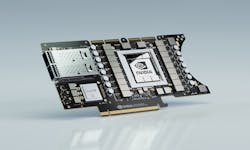Nvidia to Buy Arm in Deal Valued at About $40 Billion
Nvidia said that it would buy chip designer Arm from SoftBank in a cash-and-stock deal valued at up to $40 billion, a move that could reshape the landscape of the global semiconductor industry.
If the deal closes, it would transform Nvidia into one of the most dominant players in the market for chips used in smartphones. The deal would also strengthen the Santa Clara, California-based company's stature in other areas of the technology industry, including the Internet of Things—the tiny computers slapped on factory floors, cars, street lights, thermostats, and billions of other devices that communicate wirelessly—and cloud data centers.
The announcement on Sunday confirmed months of rumors about a possible deal. SoftBank, which purchased Arm for around $32 billion in 2016, has reportedly been considering a potential sale or initial public offering for the chip designer in recent months.
The technology conglomerate will have an ownership stake in Nvidia of less than 10% following the deal. “SoftBank is excited to invest in Arm’s long-term success as a major shareholder in Nvidia,” the firm's chief executive officer, Masayoshi Son, said in a statement.
Nvidia sells graphics processing units (GPUs) for playing games on personal computers and carrying out artificial intelligence chores in data centers. It also develops networking chips for ferrying around warehouses of cloud servers. Arm designs central processing units (CPUs) and other intellectual property that other companies assemble into chips that power in most of the world's smartphones. Arm designs are also starting to play a deeper role in cloud data centers.
"Uniting Nvidia's AI computing capabilities with the vast ecosystem of Arm's CPU [technology], we can advance computing from the cloud, smartphones, PCs, self-driving cars and robotics to edge IoT and expand AI computing to every corner of the globe," Jensen Huang, chief executive and co-founder of Nvidia, said in a statement. He added that the deal would "create the leading company computing company for the age of AI."
Report: Graphene Market to Reach 3.2 Million by 2027
Reportlinker.com has released the report “Global Graphene Electronics Industry,” which predicts a market of $2 billion by 2027. The market is predicted to grow at a CAGR of 33.4% between 2020-2027. The graphene film sector is expected to hit a CAGR of 36.8% and $2.1 billion by 2027. The U.S. graphene market is estimated at $113.6 million by the end of the analysis period. Market size in China is expected to be $875.3 million by 2027, with a CAGR of 41.7% from 2020-2027.
European Trade Shows Return With a New Look
Emerging from the fetters brought on by the COVID-19 pandemic, trade shows and exhibitions in Europe are materializing in the autumn of 2020, but with a different presence and lower profit margins, according to a September report by The Wall Street Journal.
Though the shows combine diminished in-person action with an online version, organizers are testing to determine what works, until economies recover and can doff the yoke of COVID-19 precautions. “One thing is for certain; there will be hybrid trade shows in the future that will take place in the real world but will also be bolstered by digital media,” said Ernst Kick, chief executive of Spielwarenmesse eG, which organizes an annual toy fair in Nuremberg, Germany.
The Berlin IFA consumer electronics show, which hosted 2300 exhibitors and 600,000 attendees last year, was closed to the general public, with near-silent halls. According to the UFI, the global association of the exhibition industry, global revenues for trade fairs and exhibitions fell by two-thirds during the first half of 2020, with 39% of show-hosting companies taking a loss.
Printed Electronics Market Worth $20.7 Billion by 2025
The global printed electronics market is projected to grow from $7.8 billion in 2020 to 20.7 billion by 2035, growing at a CAGR of 21.5% during that period, according to a report by ResearchAndMarkets.com.
The report further states, “The growth of the market is mainly driven by the rise in the global demand for energy-efficient, thin, and flexible consumer electronics, and increased use of printed electronics for the development of smart and connected devices. Also, the high demand for new generation flexible printed electronics, and significant cost advantages offered by printed electronics is set to push the Printed Electronics market.” During the forecast period, the automotive & transportation industries are projected to hold the largest size of the market.
